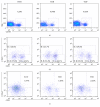The Imbalance of B-Lymphocyte Subsets in Subjects with Different Glucose Tolerance: Relationship with Metabolic Parameter and Disease Status
- PMID: 28491871
- PMCID: PMC5410374
- DOI: 10.1155/2017/5052812
The Imbalance of B-Lymphocyte Subsets in Subjects with Different Glucose Tolerance: Relationship with Metabolic Parameter and Disease Status
Abstract
B lymphocytes are involved in inflammation and are related to insulin resistance in obesity and type 2 diabetes (T2D). This study investigated the phenotype and frequency of B-lymphocyte subsets in subjects recently diagnosed with T2D (n = 60), impaired glucose regulation (IGR, n = 73), and normal glucose tolerance (NGT, n = 169) by flow cytometry. T2D subjects had an increased percentage of CD19+CD23+ (B-2) cells and a decreased percentage of CD19+CD23- (B-1) cells attributing to CD19+CD23-CD5- (B-1b) cells, but not CD19+CD23-CD5+ (B-1a) cells, compared to NGT and IGR subjects. The proportion of CD19+CD5+CD1dhi (B10) cells did not differ between the IGR or T2D group and NGT controls. Of note, HbA1c and triglyceride showed a positive correlation with B-2 cells but an inverse correlation with B-1 and B-1b cells, which were independently associated with the presence of T2D by logistic regression models. In summary, this study shows an unbalanced proinflammatory phenotype of B-cell subsets correlated with glycemia and lipidemia in patients with T2D. Our data provide new insight into chronic activation of the immune system and subclinical inflammation in T2D. Further prospective studies are warranted to confirm our observations.
Figures



References
-
- Ligthart S., van Herpt T. T., Leening M. J., et al. Lifetime risk of developing impaired glucose metabolism and eventual progression from prediabetes to type 2 diabetes: a prospective cohort study. The Lancet Diabetes and Endocrinology. 2016;4(1):44–51. doi: 10.1016/S2213-8587(15)00362-9. - DOI - PubMed
MeSH terms
Substances
LinkOut - more resources
Full Text Sources
Other Literature Sources
Medical

